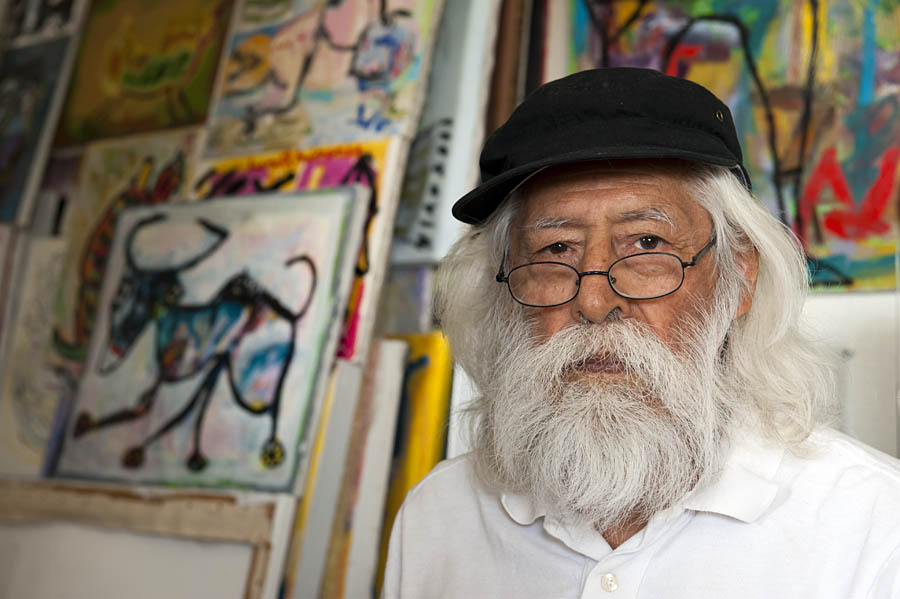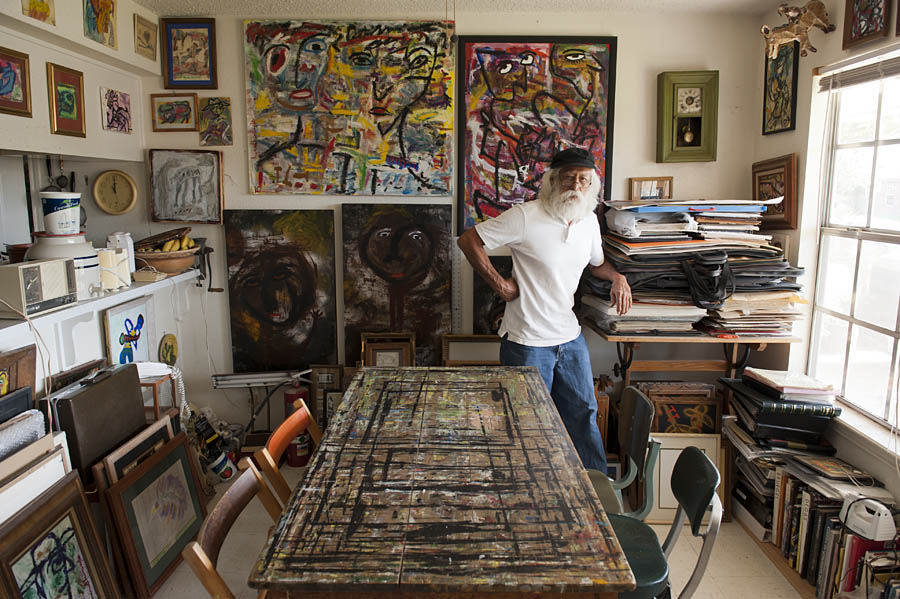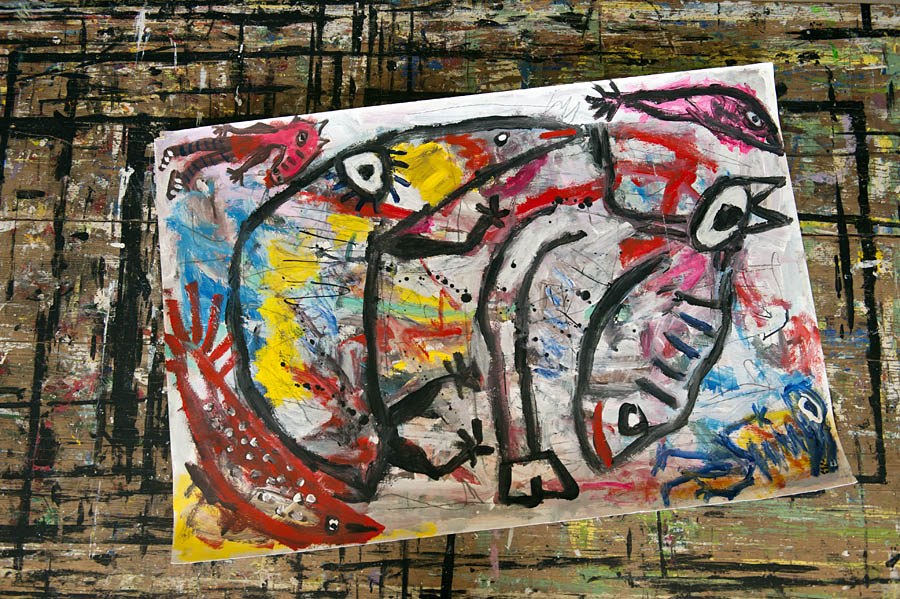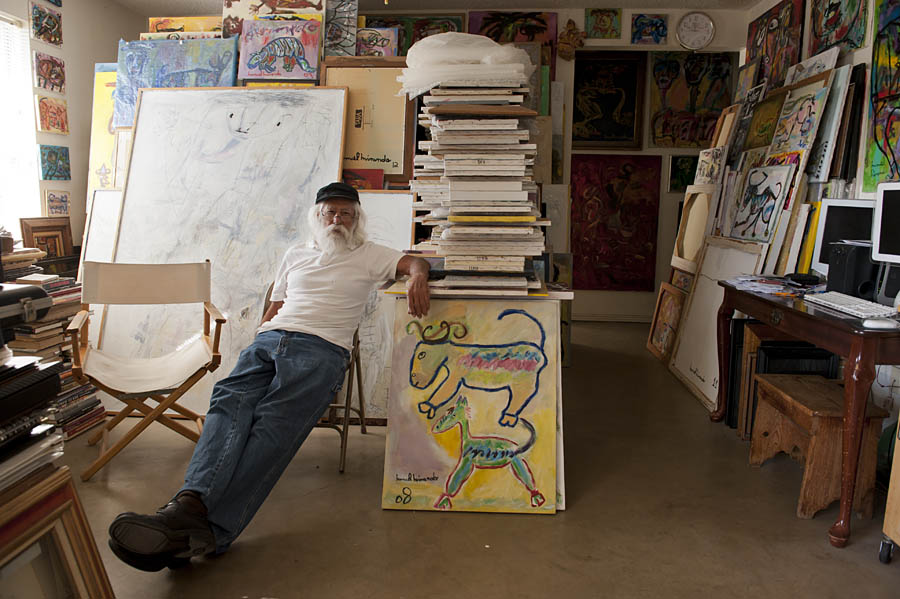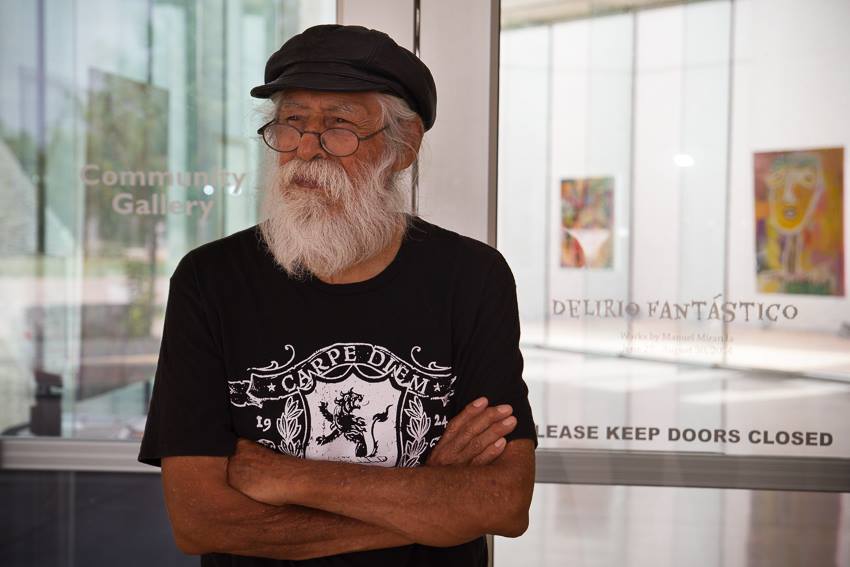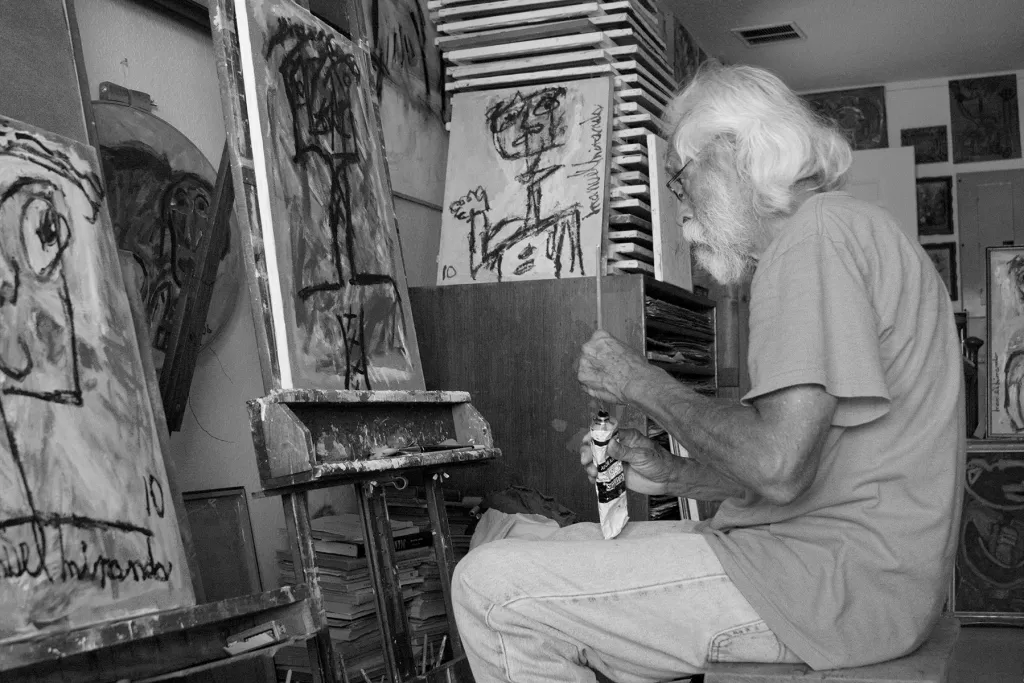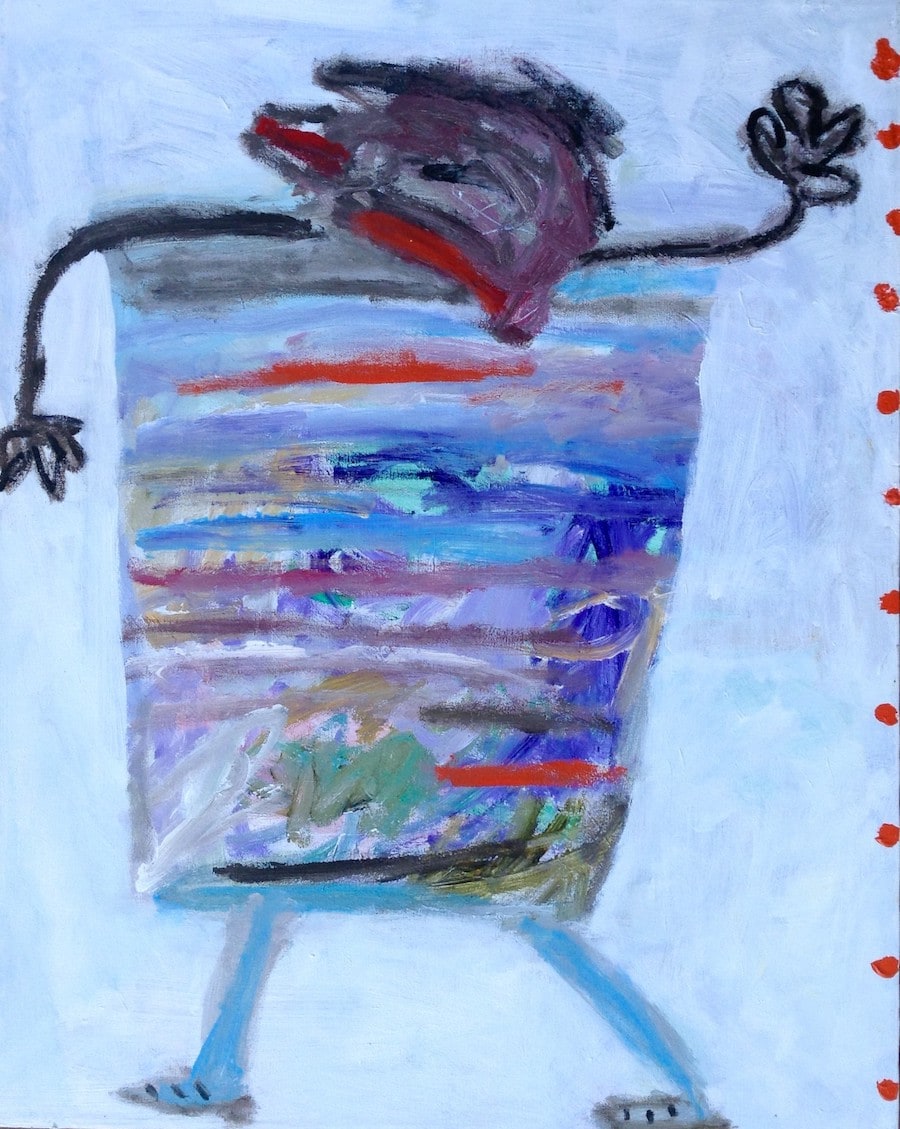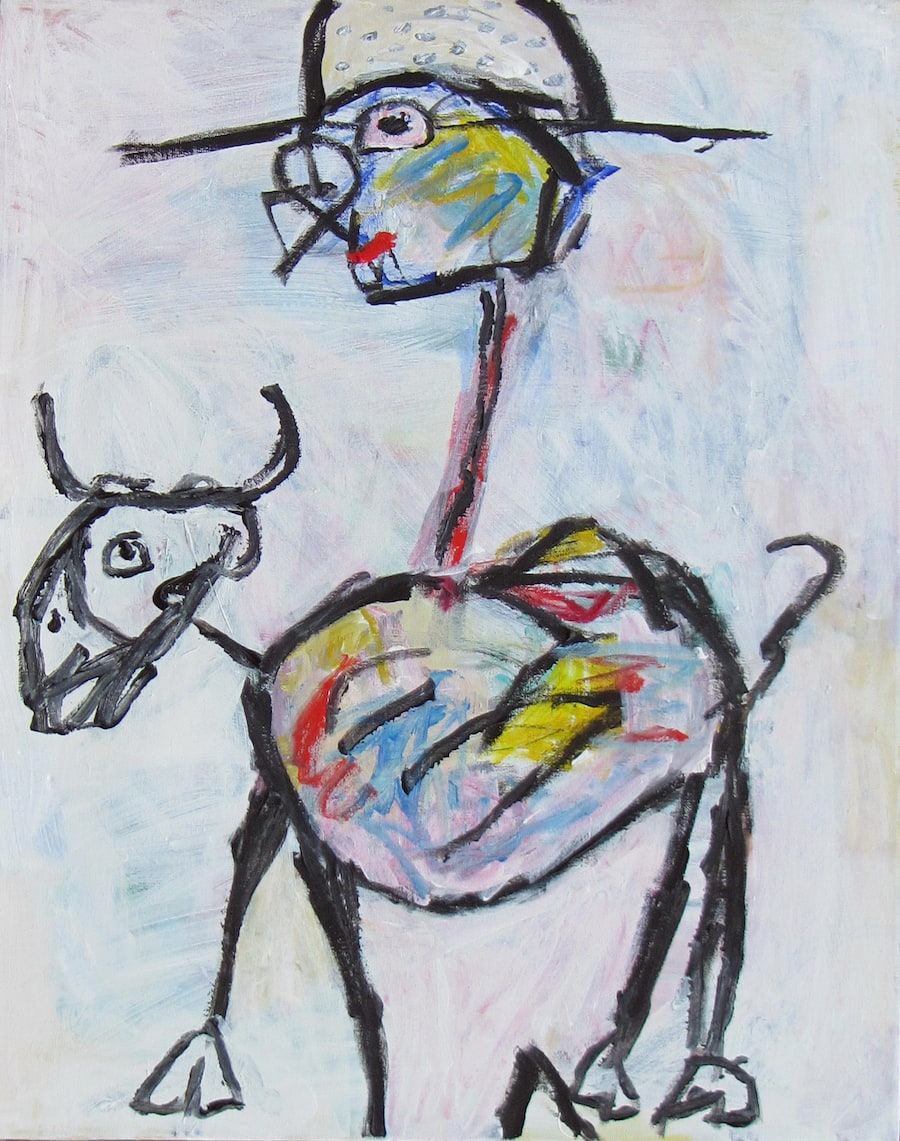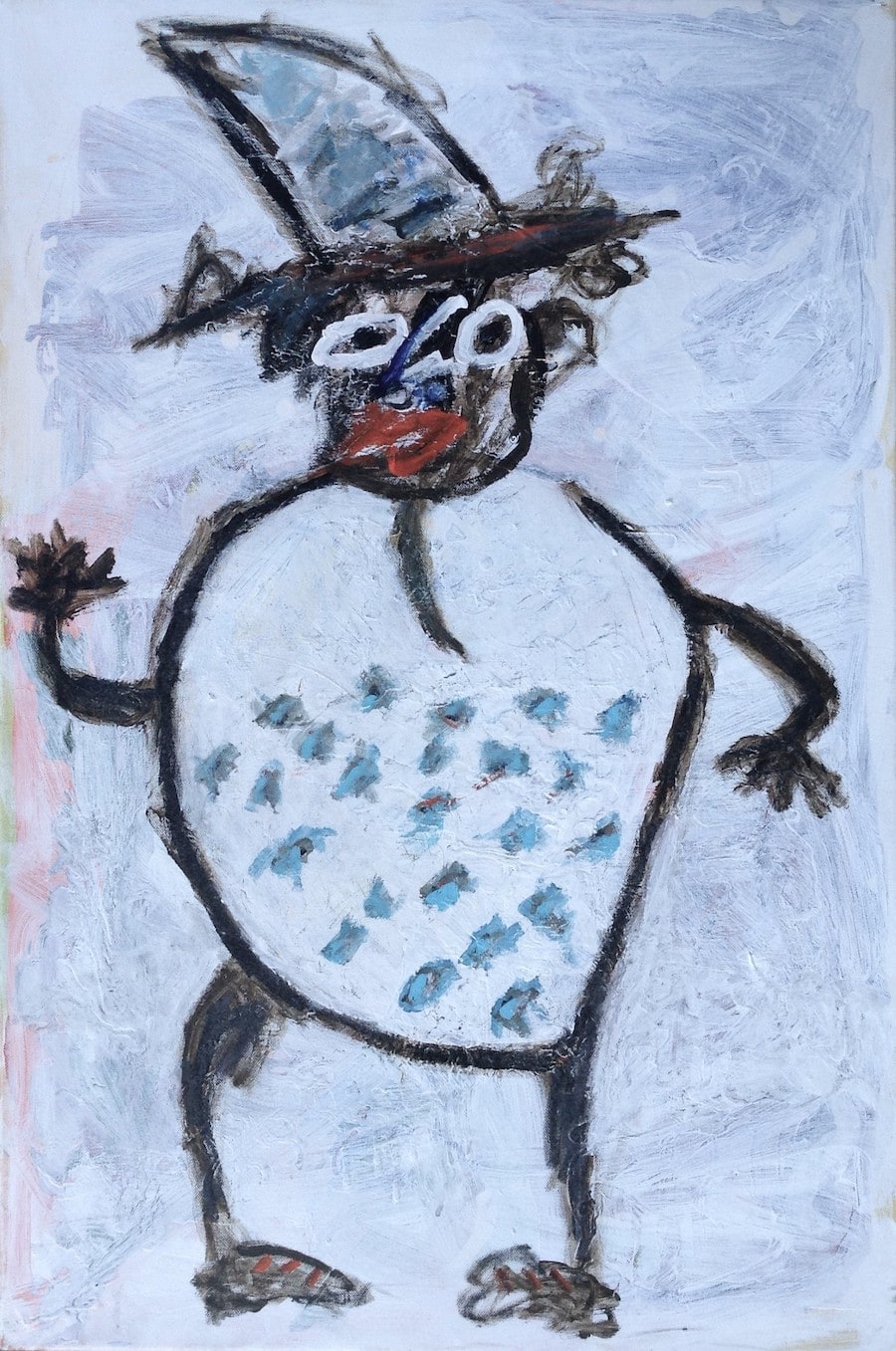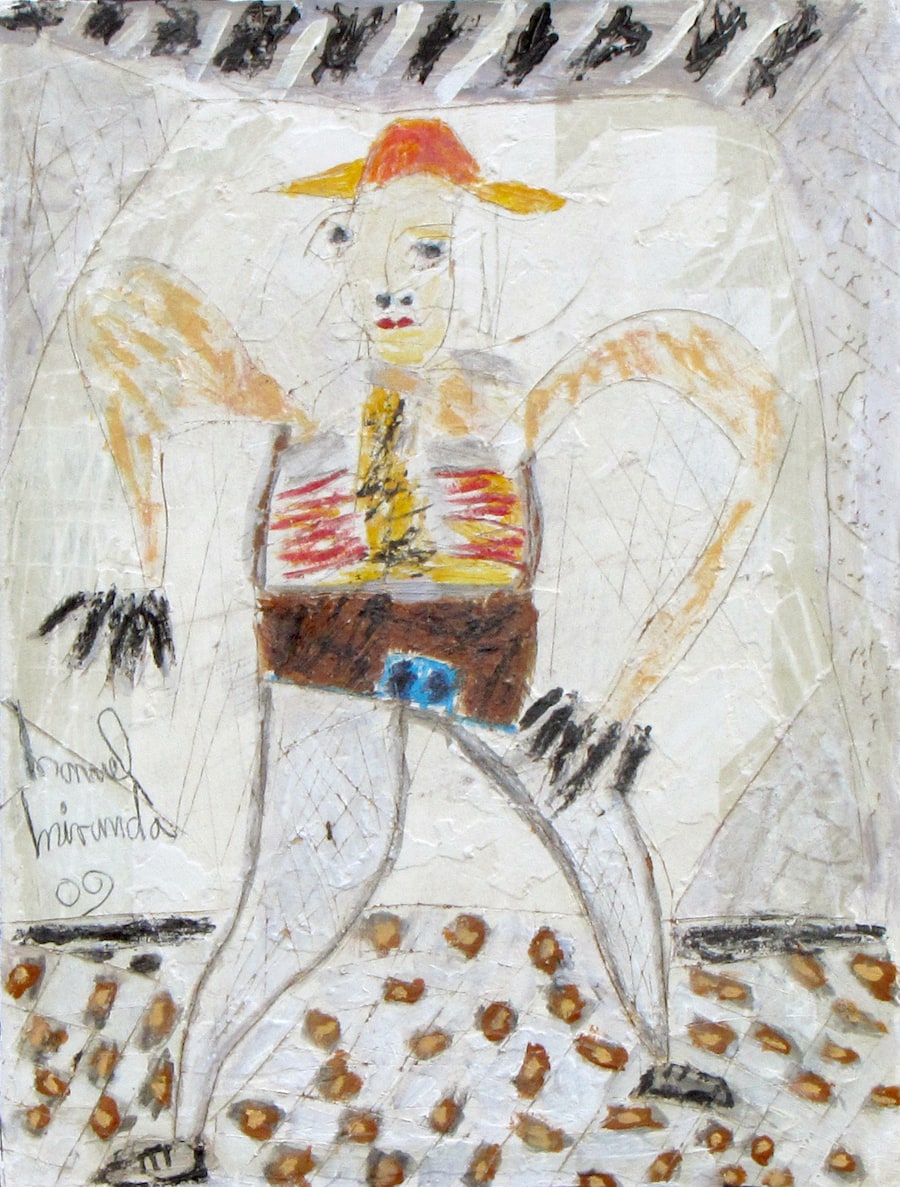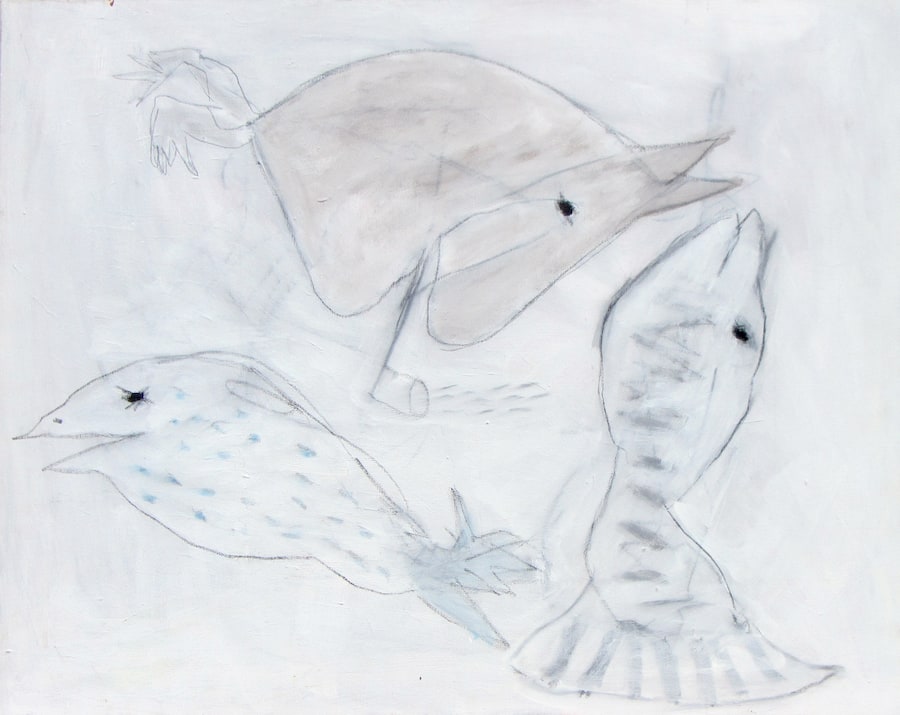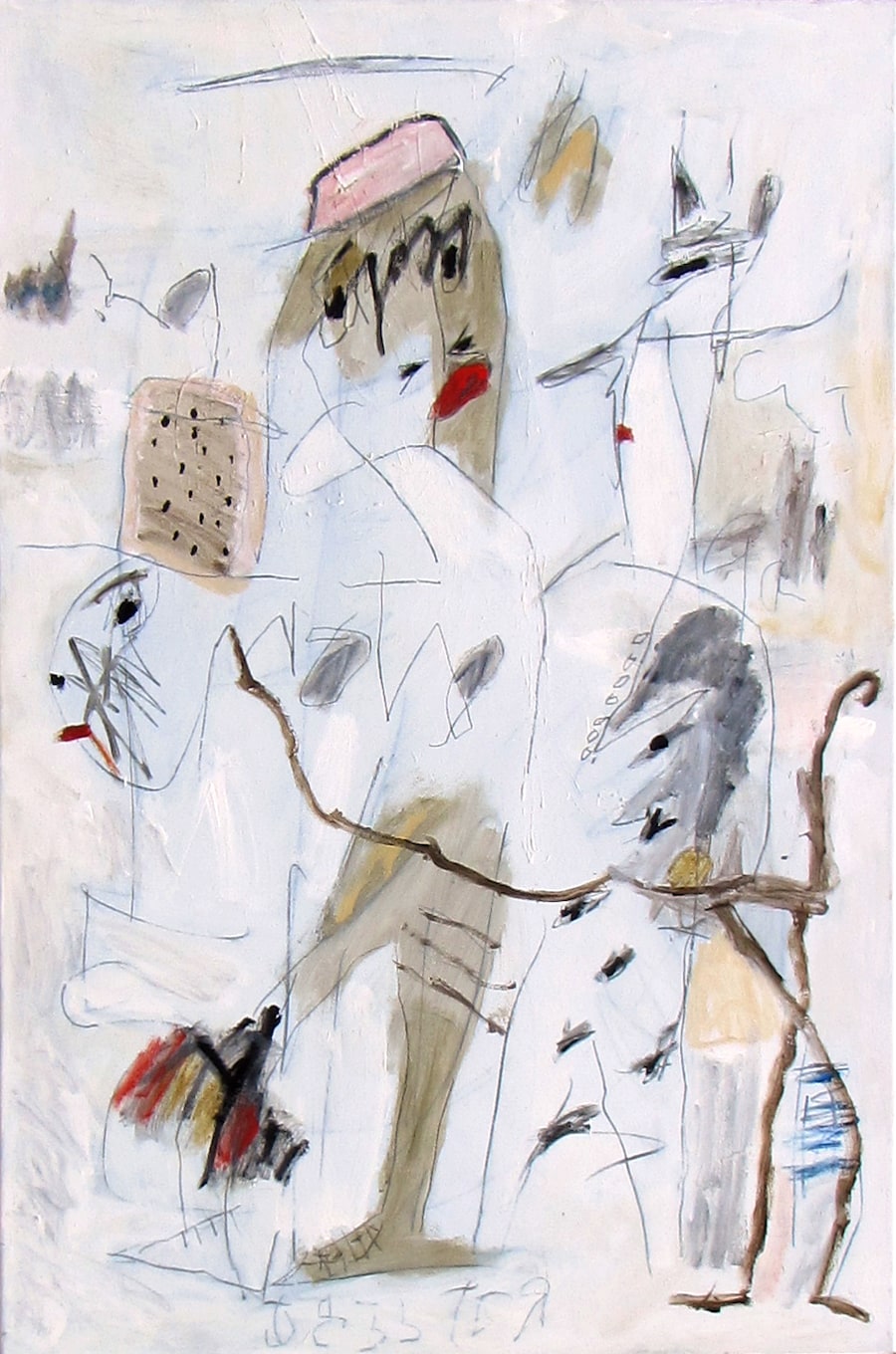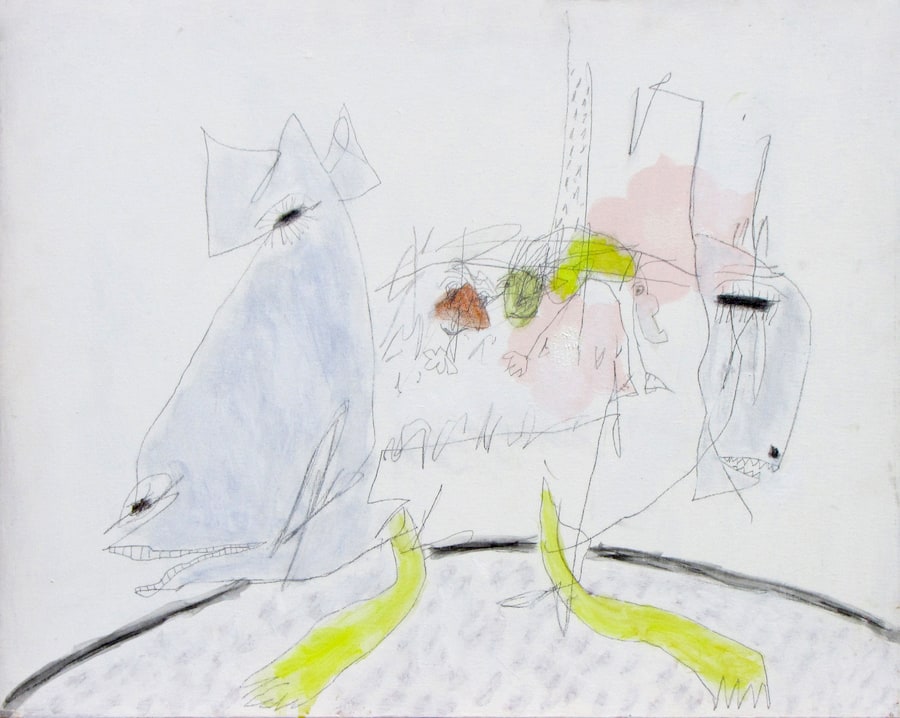Manuel Miranda
Summary
- 1935 Born in San Angel, México City.
- 1967 Studied Spanish Literature, National Autonomous University of México. Began painting
- and drawing
- 1981 Started illustrating for well-known cultural publications in México City
- 2000 Moved to McAllen, TX
- 2010 Represented by Galería 409 , Brownsville, TX
- 2010 Represented by Koelsch Gallery, Houston, TX
- 2012 Represented by Udinotti Gallery, Scottsdale, AZ
- 2021 Represented by Puente Art Studio, Brownsville, TX
Selected Solo Exhbitions
- 2024 “The Whimsical World of Manuel Miranda. An Exhibition of Painting at the Udinotti Gallery. October 27th, 2024 Scottsdale Arizona.
- 2024 “Art Exhibit by Manuel Miranda” In the Lobby of San Isidro Currency Exchange House: “Marile Gallery,” McAllen, TX. June 2024.
- 2023 “Retrospectiva de un Viaje Existencial.” Art Exhibit by Manuel Miranda. Gobierno de Reynosa and Instituto Reynosense para la Cultura y las Artes, at Museo Historico de Reynosa. August 25, 2023.
- 2022 “The Art of the Bull” A Virtual Art Exhibit by Manuel Miranda, with the Emma S. Barrientos Mexican American Cultural Center. Austin, Texas and the Smithsonian Learning Lab. January 2022.
- 2021 “The Art of the Bull” A Virtual Art Exhibit by Manuel Miranda, with the Emma S. Barrientos
- Mexican American Cultural Center. Austin, Texas and the Smithsonian Learning Lab. January 2022.
- 2021 “El Poder de la Mirada” at Puente Art Studio. Brownsville, TX. December 4th, 2021.
- 2020 “Retablos multicolores con pájaros enternecidos”. Online Art Exhibition by Manuel Miranda, at Mark Clark’s “Mi Vida Loca Gallery”. Corpus Christi, TX. August 8, 2020.
- 2020 “The Art of the Bulls”. An Online Art Exhibit by Manuel Miranda, at Estrada Garcia Gallery. Georgetown, TX. June 2020.
- 2019 “Once in a While…Little Bulls” An art exhibition by Manuel Miranda at Estrada Garcia Gallery in Taylor, TX August 15th, 2019.
- 2019 “Manuel Miranda’s Art Work “La integración de la Disociación” at Papi’s Pies Gallery in Round Rock, TX.
- 2016 “The Work of Manuel Miranda and Larry McLaughlin” at Udinotti Gallery in Scottsdale Az. October 6, 2016.
- 2015 “The Tenderness of Egocentrism,” The Drawings of Manuel Miranda at The Cole Art Center, The Old Opera House. Nacogdoches,TX. October 24, 2015.
- 2015 “Contextos Históricos y Poéticos,” Manuel Miranda’s Art Exhibit at UNAM US SA. San Antonio TX. March 7, 2015.
- 2015 “Invención Varia,” a Retrospective Art Exhibit by Manuel Miranda at Galería 409. Brownsvile, TX. January, 2015.
- 2022 “La Cultura en Mí” FDCLA Latino Film Festival & CIMA Gallery Exhibition. UNT Department of Media Arts. Denton, TX. September 10th, 2022.
- 2014 “Delirio Fantástico,” Art Exhibit by Manuel Miranda at The Emma Barrientos Mexican American Cultural Center. Austin, TX. June 27, 2014.
- 2014 “Delirio Fantástico,” Manuel Miranda’s Art Exhibit at Koelsch Haus, Houston, TX. December 13, 2014.
- 2014 “Lo Maravilloso Cotidiano,” Exposición Plástica del Artista Visual Manuel Miranda at Museo Histórico Reynosa. Tamaulipas, México. January 17, 2014.
- 2013 “Trick Play,” at The Art Center of Waco. McLennan Community College. Waco, TX. March 1, 2013.
- 2013 “New Works by Manuel Miranda,” at Koelsch Gallery. Houston, TX. January 19, 2013.
- 2012 “Pleiades, Jongleurs, Masters and Humanists,” at Main McAllen Public Library. McAllen,TX. October 25, 2012.
- 2012 “The Work of Manuel Miranda and Jed Thomas,” at Udinotti Gallery. Scottsdale, AZ. November 1, 2012.
- 2012 “Outgoing Animals,” at South Texas College Technology Campus. McAllen, TX. September 27, 2012.
- 2011 “Nearly Human. Nearly Animal,” Manuel Miranda at Koelsch Gallery. Houston, TX. February 3, 2011.
- 2010 “Alianzas (Alliances),” at Galería 409. An Art Exhibition by Manuel Miranda, at Brownsville, TX. October 16, 2010.
- 2010 “The Art of Manuel Miranda,” A Retrospective Exhibition, at Upper Valley League.
- Mission, TX. June 12, 2010.
- 2010 “Encuentros (Encounters),” The Art of Manuel Miranda, at Brownsville Museum of Fine
- Arts. Brownsville, TX. May 31, 2010.
- 2009 “Metáforas (Metaphors),” at Manichaus Modern Art Space. McAllen, TX. August 7, 2009.
- 2002 “Manuel Miranda en Seguin,” at Art in Process Gallery and Studio. Seguin, TX. June 8, 2002.
- 2001 “Manuel Miranda,” an International Artist Exhibit, at Art Awakening Gallery. McAllen. TX. February 8, 2000.
- 2000 “Mujeres, Mujeres, Mujeres,” at El Teatro de Reynosa. Reynosa Tamaulipas, México. June 25, 2000.
- 1995 “El Arte Pictórico de Manuel Miranda,” at Galería Argentum. México City. December 1995.
- 1991 “Bestiario,” Dibujos, at Museo del Chopo (UNAM). México City. May 22, 1991.
- 1991 “Dibujos,” at Galería del Bosque, Casa del Lago, Antiguo Bosque de Chapultepec. México City. April 4, 1991.
- 1991 ”El Arte de Manuel Miranda,” at Sistema de Transporte Colectivo Metro, Estación Barranca del Muerto. (México City, Line 7 Subway) México City. February 22, 1991.
- ____________________________________________________________
- Selected Group Exhibitions
- 2024 “49th International Juried Art Show Brownsville Museum of Fine Arts” Curated by Alison
- de Lima Greene, the Isabel Brown Wilson curator of Modern and Contemporary Art at the
- Museum of Fine Arts, Houston. At BMFA in Brownsville, TX. September 20, 2024. Third Prize Winner in its Category
- 2023 “2023 National Juried Exhibition”. Curated by Susanna Coffey at First Street Gallery in Chelsea New York. August 3,2023.
- 2022 “La Cultura en Mí” FDCLA Latino Film Festival & CIMA Gallery Exhibition. UNT Department of Media Arts. Denton, TX. September 10th from 10 AM to 10 PM (single day,) 2022.
- 2022 “8 X 10, Selfportrait,” Group Exhibit at Mi Vida Loca Gallery. Corpus Christi, TX. July 21, 2022.
- 2022 “Group Exhibit” Art for Real II Edition. Boomer Gallery. London, UK. July 8, 2022.
- 2021 “Group Exhibition of Recent Work” at The Udinotti Gallery, October 17th, 2021.
- 2020 “Sunhouse Work Project”, Archive of Today’sSouthwest. Website Work Project by Ali Dipp, funded by The Royce Fellowship at Brown University, Providence R.I. September 7th, 2020.
- 2020 “New Horizons Art Exhibit” at Harlingen Arts and Heritage Museum. Harlingen, TX. May 30, 2020.
- 2019 “A Group Exhibition” . Udinotti’s Gallery. October 27, 2019 Scottsdale, AZ.
- 2018 “Ears of Buddha” Group Exhibition at Koelsch Gallery, February 17, 2018.
- 2018 “ A Group Exhibition” at Udinotti Gallery. January 21, 2018. Scottsdale, AZ.
- 2017 “UMOFA 10th Annual Celebration”. From the Udinotti Museum of Figurative Art
- Permanent Collection. November 26, 2017. Paradise Valley, AZ.
- 2017 “The Art of the Bicycle Show” at Galería 409. Brownsville, TX. March 15, 2017.
- 2017 “Group Show” at Udinotti Gallery in Scottsdale, AZ. March 9, 2017.
- 2016 “Group Exhibition,” at Udinotti Gallery. Scottsdale, AZ. April 28, 2016.
- 2016 “Dead or Alive,” Art Collection of Cande Aguilar at Galería 409. Brownsville,TX. April 15, 2016.
- 2015 “Group Exhibition,” at Udinotti Gallery. Scottsdale, AZ. November 7, 2015.
- 2015 “UVAL Tower Artists Fine Art Exhibition,” at Chase Tower Building Lobby. McAllen TX. December 10, 2015.
- 2013 “TX 13th TEXAS BIENNAL, Arte de la Frontera II,” at IMAS. September 26, 2013.
- 2013 “Self,” An Art Exhibition of Self Representation and Imagination, at Beyond Arts Gallery. Harlingen TX. September 12, 2013.
- 2013 “7.1 Galería 409 Annual Invitational Exhibition,” Galería 409. Brownsville, TX. September 5, 2013.
- 2013 “Converging cultures,” Work by Latino Artists. University of Mary Washington
- Galleries. Fredericksburg, VA. September 6, 2013.
- 2013 “Texas National 2013,” Competition and Exhibition. Juror Peter Selz. Stephen F. Austin State University. Nacogdoches, TX. April 13, 2013.
- 2013 “Coastal Art,” at Santa Anita Gallery. McAllen TX. March1st, 2013.
- 2012 “National,” An exhibition of Río Grande Valley Painters Receiving National Recognition.
- Galería 409. Brownsville, TX. November 8, 2012.
- 2012 “6th Annual Invitational Show,” Galería 409. Brownsville, TX. September 6, 2012.
- 2012 “2012 Gateway to Imagination,” A National Juried Art Competition. Juror Hugh Wilson.
- Farmington Museum. Farmington, New Mexico. May 19, 2012.
- 2011 “3rd Annual Mix ’n’ Mash,” Exhibit and Art Sale. Mexic-Arte Museum. Austin, TX. December 2, 2011.
- 2011 “5th Annual 409 Invitational,” “Blue” Art Exhibition. Galería 409. Brownsville, TX. September 1st, 2011.
- 2011 “Texas Artists Exhibition,” Beevile Art Museum. Beeville, TX. August 6, 2011.
- 2011 “110: 2011 Summer Group Show,” Cohn Drennan Contemporary. Dallas, TX. July 9, 2011.
- 2011 Finalist at “The Hunting Art Prize,” at Friedkin Corporate Campus, Gulf States
- Toyota. Houston, TX. April 30, 2011.
- 2010 “Good Gulf,” Art Car Museum. Houston, TX. December 6, 2010.
- 2010 “Membership Show,” McKinney Avenue Contemporary. Dallas, TX. May, 2010.
- 2009 “Mix ‘n’ Mash Exhibit,” Mexic-Arte Museum. Austin, TX. December, 2009.
- 2008 “Singularity.” Manichaus Modern Art Space. McAllen, TX. December, 2008.
- 2008 “Contemporary Art Exhibit,” at The Atrium. Sponsored by PGA Studio. McAllen, TX. October 2, 2008.
- 2005 “Río Grande 5th Biennial Regional Visual Arts Exhibit,” International Museum of Art and Science. McAllen, TX. July 7, 2005.
- 2004 “Et Al,” South Texas Community College. McAllen, TX. February 19, 2004.
- 1997 “Roberto Acuña, Arely Gomez and Manuel Miranda,” University of Acapulco. Acapulco Guerrero, México. August 1997.
- 1997 “¡Viva el Arte! Arte Vivo,” La Gran Plaza. Acapulco Guerrero, México. October 1, 1997
- 1994 “Art in Plural’s Life,” SART Gallery. México D.F., México. 1994.
- 1994 “The 450 issues of El Búho,” El Búho, Excelsior Cultural Supplement, at José Luis Cuevas Museum. México City. April 21, 1994.
- 1993 “The 400 issues of El Búho,” El Búho, Excelsior Cultural Supplement. Excelsior Newspaper Gallery. México City. May 12, 1993.
- 1992 “First National Convocation for Creating a Catalog of illustrators for infant and Juvenile
- Publications,” at Carrillo Gil Museum, National Institute of Fine Arts. México City, 1992.
- 1982 “Abstractions II,” an exhibit of pastels, drawings and washes by Manuel Miranda, Victor Moran and Alejandro Segrove. At Xochil Gallery. Mission TX. April 11, 1982.
- ___________________________________________________________________
- Selected Bibliography / Works Written About Manuel Miranda
- 2015 Bravo, Joseph. Former Director of McAllen International Museum of Art and Science.
- “The Tenderness of Egocentrism,” for the Cole Art Center exhibition. Nacogdoches,
- TX. October 24, 2015.
- 2012 Moyer, Nancy. Professor Emerita of UT-RGV School of Art. “Psyches Exposed,”
- An Artist’s View of the Human Condition.” The Monitor: Surface Treatment. McAllen,
- TX. December 3, 2012.
- 2010 Cahn, Jennifer Ph.D. Former Brownsville Museum of Fine Art Curator. “Encuentros:
- The Art of Manuel Miranda,” for The Brownsville Museum of Fine Art exhibition.
- Brownsville, TX. May 31, 2010.
- 2010 Whitehead,Travis. “Manuel Miranda: Art Exhibit to Open.” The Brownsville Herald.
- Brownsville, TX. October 15, 2010.
- 2010 Whitehead, Travis. “A World of Pure Imagination.” The Brownsville
- Herald. Brownsville, TX. May 30, 2010.
- 2009 Ramey, Leslie. “Metáforas.” Special to The Monitor. McAllen, TX. August 8,
- 2009.
- 2009 ” Moyer, Nancy. Professor Emerita of UT-RGV School of Art. “Artist Manuel Miranda’s
- Masterful Metaphors.” The Monitor. McAllen, TX. August 15, 2009.
- 2008 Robledo, David. “Ponitosco.” South Texas Nation Review. McAllen, TX. October
- 2008.
- 2006 Whitehead, Travis. “Mexico City Artist Keeps his Inner Child Alive.”The Monitor.
- McAllen, TX. December 1, 2006.
- 2002 Hinojosa, Noe “Into the Mind of Manuel Miranda.” Mesquite Review. McAllen, TX.
- December 2002.
- 2001 Ramos, Fred. “Río Fest offers up arts, music.” Valley Morning Star. Harlingen, TX
- April 21, 2001.
- 1995 Reyes Nevares, Juan José. “ Manuel Miranda: Colores que Vuelan” Semanario
- Cultural de Novedades . México City. December 17, 1995.
- 1991 Rodriguez, Antonio. “Manuel Miranda: De la Realidad a la Ficción Creativa.”
- Casa del Lago exhibition’s invitation. México City. April 1991.
- 1991 Tavera, Oscar.“ The Drawings of Manuel Miranda.”El Búho, Excelsior’s Cultural
- Newspaper. April 14, 1991.
- 1986 Reyes Nevares, Juan José. “Manuel Miranda: The Colors of Childhood.” El Nacional
- September 13, 1986.
- 1982 Field, Phillip and Field Janice.“Fort the Love of Art,” The Valley Town Crier. May 5, 1982
- Permanent Collections / Works by Manuel Miranda.
- ________________________________________________________________________
- Permanent Collections
- 2022 “The Art of the Bull” A Virtual Art Exhibit by Manuel Miranda, with the Emma S. Barrientos
- Mexican American Cultural Center. Austin, Texas and the Smithsonian Learning Lab. January 2022.
- 2017 Permanent Collection, Two Art pieces by Manuel Miranda at Museum of Figurative Art
- In Paradise Valley Arizona. Jan 2017.
- 2014 Unveiling Reception for Manuel Miranda’s large-scale paintings for the McAllen Public
- Library’s Permanent Collection. May 04, 2014. McAllen, TX.
- ________________________________________________________________
- COMPETITIONS & AWARDS
- 2024 “49th International Juried Art Show Brownsville Museum of Fine Arts” Curated by Alison
- de Lima Greene, the Isabel Brown Wilson curator of Modern and Contemporary Art at the
- Museum of Fine Arts, Houston. At BMFA in Brownsville, TX. September 20, 2024. Third Prize Winner in its Category
- 2023 “2023 National Juried Exhibition.” Curated by Susanna Coffey, at First Street Gallery in Chelsea, New York. August 3, 2023.
- 2020 “Sunhouse Work Project”, Archive of Today’sSouthwest. Website Work Project by Ali Dipp, funded by The Royce Fellowship at Brown University, Providence R.I. September 7th,
- 2020.
- 2013 “La Frontera: Artists Along the US-Mexican Border” Participation in the photographic project of the New York photographer Stefan Falke.
- 2013 “TX 13th TEXAS BIENNAL, Arte de la Frontera II,” at IMAS. September 26, 2013.
- 2013 “Converging cultures,” Work by Latino Artists. University of Mary Washington
- Galleries. Fredericksburg, VA. September 6, 2013.
- 2013 “Texas National 2013,” Competition and Exhibition. Juror Peter Selz. Stephen F. Austin State University. Nacogdoches, TX. April 13, 2013.
- 2012 “National,” An exhibition of Río Grande Valley Painters Receiving National Recognition.
- Galería 409. Brownsville, TX. November 8, 2012.
- 2012 “2012 Gateway to Imagination,” A National Juried Art Competition. Juror Hugh Wilson.
- Farmington Museum. Farmington, New Mexico. May 19, 2012.
- 2011 Finalist at “The Hunting Art Prize,” at Friedkin Corporate Campus, Gulf States
- Toyota. Houston, TX. April 30, 2011.
- 2005 “Río Grande 5th Biennial Regional Visual Arts Exhibit,” International Museum of Art and Science. McAllen, TX. July 7, 2005.
- 1992 “First National Convocation for Creating a Catalog of illustrators for infant and Juvenile
- Publications,” at Carrillo Gil Museum, National Institute of Fine Arts. México City, 1992.
